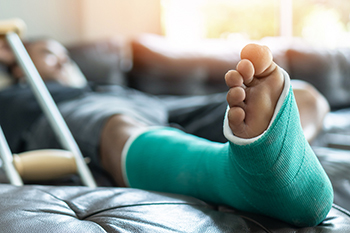Blog
Items filtered by date: March 2023
Tuesday, 28 March 2023 00:00
Ingrown Toenail Surgery Aftercare

An ingrown toenail is a condition of the foot that occurs when the side of the nail grows into the skin surrounding the nail bed. As a result, there can be inflammation at the site of the side of the toenail. Some cases of ingrown toenails are so severe that surgery is needed to correct the condition. Many patients want to know what they should be doing after undergoing a surgical procedure. You should always listen to the advice and instructions of your medical professional, such as a podiatrist. They might tell you to rest the foot in the days following surgery. The instructions that your medical professional gives you might also include ways in which you can reduce the risk of developing an infection of some kind. If you are afflicted with an ingrown toenail, then it is suggested that you are under the care of a podiatrist.
Ingrown toenails can become painful if they are not treated properly. For more information about ingrown toenails, contact one of the podiatrists of JE Foot & Ankle Associates. Our doctors can provide the care you need to keep you pain-free and on your feet.
Ingrown Toenails
Ingrown toenails occur when a toenail grows sideways into the bed of the nail, causing pain, swelling, and possibly infection.
Causes
- Bacterial infections
- Improper nail cutting such as cutting it too short or not straight across
- Trauma to the toe, such as stubbing, which causes the nail to grow back irregularly
- Ill-fitting shoes that bunch the toes too close together
- Genetic predisposition
Prevention
Because ingrown toenails are not something found outside of shoe-wearing cultures, going barefoot as often as possible will decrease the likeliness of developing ingrown toenails. Wearing proper fitting shoes and using proper cutting techniques will also help decrease your risk of developing ingrown toenails.
Treatment
Ingrown toenails are a very treatable foot condition. In minor cases, soaking the affected area in salt or antibacterial soaps will not only help with the ingrown nail itself, but also help prevent any infections from occurring. In more severe cases, surgery is an option. In either case, speaking to your podiatrist about this condition will help you get a better understanding of specific treatment options that are right for you.
If you have any questions please feel free to contact one of our offices located in Fleming Island and Palm Coast, FL . We offer the newest diagnostic and treatment technologies for all your foot and ankle needs.
Tuesday, 21 March 2023 00:00
Possible Reasons for Lateral Foot Pain

Lateral foot pain refers to pain that runs along the outside of the foot and ankle. This can make it difficult for one to perform their everyday activities. This type of pain can come from a variety of conditions or injuries, such as an ankle sprain, bunions, or cuboid syndrome. Among other things, lateral foot pain can lead to foot instability, swelling, and tenderness. A sprain happens from overstretching of a ligament in the foot or ankle. Cuboid syndrome is a partial dislocation of one of the lateral foot bones, known as the cuboid bone, from tension or excess weight on the bone. Bunions are a bone deformity that causes the big toe to bend in and point towards the smaller toes. Having a bunion can lead to one putting their body weight on the outside of the foot and causing pain there. Since there are other reasons one might have lateral foot pain, if you suffer from such discomfort, it is suggested that you consult with a podiatrist who can make a proper diagnosis and provide treatment options
Foot and ankle trauma is common among athletes and the elderly. If you have concerns that you may have experienced trauma to the foot and ankle, consult with one of the podiatrists from JE Foot & Ankle Associates. Our doctors will assess your condition and provide you with quality foot and ankle treatment.
Foot and ankle trauma cover a range of injuries all over the foot; common injuries include:
- Broken bones
- Muscle strains
- Injuries to the tendons and ligaments
- Stress fractures
Symptoms
Symptoms of foot and ankle injuries vary depending on the injury, but more common ones include:
- Bruising
- Inflammation/ Swelling
- Pain
Diagnosis
To properly diagnose the exact type of injury, podiatrists will conduct a number of different tests. Some of these include sensation and visual tests, X-rays, and MRIs. Medical and family histories will also be taken into account.
Treatment
Once the injury has been diagnosed, the podiatrist can than offer the best treatment options for you. In less severe cases, rest and keeping pressure off the foot may be all that’s necessary. Orthotics, such as a specially made shoes, or immobilization devices, like splints or casts, may be deemed necessary. Finally, if the injury is severe enough, surgery may be necessary.
If you have any questions, please feel free to contact one of our offices located in Fleming Island and Palm Coast, FL . We offer the newest diagnostic and treatment technologies for all your foot care needs.
Tuesday, 14 March 2023 00:00
Why Are My Heels Cracked?

Many people do not take proper care of their feet during the colder months and a condition known as cracked heels may develop. The leading cause of cracked heels during the colder months is due to dry skin. Cracked heels can also arise from standing on hard surfaces for most of the day as well as wearing shoes with an open back. The aging process may also affect cracked heels because of the loss of skin elasticity. Existing medical conditions like eczema, psoriasis, athlete’s foot, and diabetes may lead to cracked heels. Deep cracks are called fissures and they may bleed and become infected. Additionally, people who are overweight may be prone to developing cracked heels, which adds extra pressure to the heels. If you suffer from cracked heels, it is suggested that you speak with a podiatrist who can prescribe medication for complete relief.
If the skin on your feet starts to crack, you may want to see a podiatrist to find treatment. If you have any concerns, contact one of the podiatrists from JE Foot & Ankle Associates. Our doctors can provide the care you need to keep you pain-free and on your feet.
Cracked Heels
It is important to moisturize your cracked heels in order to prevent pain, bleeding, and infection. The reason cracked heels form is because the skin on the foot is too dry to support the immense pressure placed on them. When the foot expands, the dry skin on the foot begins to split.
Ways to Help Heal Them
- Invest in a good foot cream
- Try Using Petroleum Jelly
- Ease up on Soaps
- Drink Plenty of Water
Ways to Prevent Cracked Heels
- Moisturize After Showering
- Skip a Shower
- Keep Shower Water Lukewarm
- Don’t Scrub Your Feet
If you are unsure how to proceed in treating cracked heels, seek guidance from a podiatrist. Your doctor will help you with any questions or information you may need.
If you have any questions, please feel free to contact one of our offices located in Fleming Island and Palm Coast, FL . We offer the newest diagnostic and treatment technologies for all your foot care needs.
Wednesday, 08 March 2023 00:00
An Ounce of Prevention for Kid’s Feet

Taking care of your children’s feet during infancy and early childhood can do a lot to help them have healthy feet as they grow. When a child shows signs of or complains of foot pain, it is wise to take them to a podiatrist to have their feet evaluated for possible problems. While children are born without arches and usually do not experience symptoms from this while they are in development, sometimes having flat feet can cause them to have problems participating in physical activities, impact their gait, or cause them pain or cramping in their feet, legs, or knees. Sever’s disease is an inflammation of the heel growth plate that can cause pain. This condition affects kids between 8 and 14 years of age or until the heel bone fully develops. Ingrown toenails can develop in children from wearing shoes that are too tight, cutting their toenails improperly, or a genetic predisposition. With this, a toenail can grow into the skin and a serious infection can result. These are just some of the problems that parents can encounter with their children’s feet. If you want to be educated on how to best care for growing feet or find that your child has foot issues, it is suggested that you consult with a podiatrist who can answer your questions and treat foot problems that arise.
Making sure that your children maintain good foot health is very important as they grow. If you have any questions, contact one of the podiatrists of JE Foot & Ankle Associates. Our doctors can provide the care you need to keep you pain-free and on your feet.
Keeping Children's Feet Healthy
Having healthy feet during childhood can help prevent medical problems later in life, namely in the back and legs. As children grow, their feet require different types of care. Here are some things to consider...
Although babies do not walk yet, it is still very important to take care of their feet.
Avoid putting tight shoes or socks on his or her feet.
Allow the baby to stretch and kick his or her feet to feel comfortable.
As a toddler, kids are now on the move and begin to develop differently. At this age, toddlers are getting a feel for walking, so don’t be alarmed if your toddler is unsteady or ‘walks funny’.
As your child gets older, it is important to teach them how to take care of their feet.
Show them proper hygiene to prevent infections such as fungus.
Be watchful for any pain or injury.
Have all injuries checked by a doctor as soon as possible.
Comfortable, protective shoes should always be worn, especially at play.
If you have any questions please feel free to contact one of our offices located in Fleming Island and Palm Coast, FL . We offer the newest diagnostic and treatment technologies for all your foot and ankle needs.
Tuesday, 07 March 2023 00:00
Reminder: When Was the Last Time...?
Blog Archives
- May 2025
- April 2025
- March 2025
- February 2025
- January 2025
- December 2024
- November 2024
- October 2024
- September 2024
- August 2024
- July 2024
- June 2024
- May 2024
- April 2024
- March 2024
- February 2024
- January 2024
- December 2023
- November 2023
- October 2023
- September 2023
- August 2023
- July 2023
- June 2023
- May 2023
- April 2023
- March 2023
- February 2023
- January 2023
- December 2022
- November 2022
- October 2022
- September 2022
- August 2022
- July 2022
- June 2022
- May 2022
- April 2022
- March 2022
- February 2022
- January 2022
- December 2021
- November 2021
- October 2021
- September 2021
- August 2021
- July 2021
- June 2021
- May 2021
- April 2021
- March 2021
- February 2021
- January 2021
- December 2020
- November 2020
- October 2020
- September 2020
- August 2020
- July 2020
- June 2020
- May 2020
- April 2020
- March 2020
- February 2020
- January 2020
- December 2019
- November 2019
- October 2019
- September 2019

